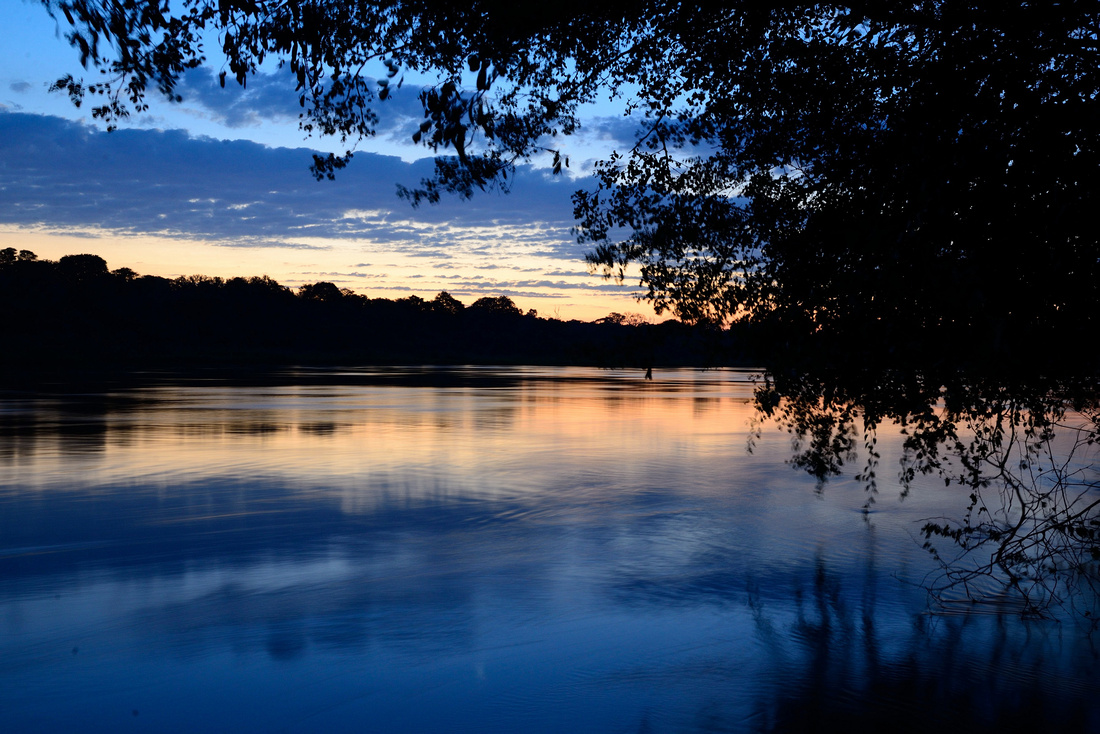Swakopmund, Etosha, the Kavango River and on to Windhoek
We spent five days in Swakopmund while Crossroads kindly re-packed our gear and cleaned the bakkie. I had a minor scare when I noticed one evening that, with my sore calf, my ankle was swollen. I was worried, with all the sitting and driving, that it might be a DVT. We took off to casualty in the town hospital. Big mistake. The receiving doctor closed her eyes, mentally shrugged and directed us to a corner, continuing to chat to a nurse. After ten minutes of this we searched on the phone for an alternative, walking out and finding a private clinic where they were most helpful. (I guess that was what she wanted us to do!)
A local doc came in, pronounced me OK although still recommending an ultrasound which proved fine - it was all because of the bump on my calf a week or so earlier – the perils of camping! My leg remained painful for a few weeks contributing to us cutting back on the amount of driving we eventually did (see later).
Our route.

 As we drove out of Swakopmund to continue our travels, I suddenly remembered I needed malaria pills, Jen previously deciding to take her chances by covering herself and using sprays. The doctor I talked to reckoned that the Etosha area was OK but as we were going further north he thought it prudent not to take chances.
As we drove out of Swakopmund to continue our travels, I suddenly remembered I needed malaria pills, Jen previously deciding to take her chances by covering herself and using sprays. The doctor I talked to reckoned that the Etosha area was OK but as we were going further north he thought it prudent not to take chances.
We drove up the coast passing a small town with colourful houses towards Henties Bay where the golf course looks a challenge, stopping at the beach to see a boat that had involuntarily found refuge in the shallows😀 then turning off onto the gravel D1918 on our way to Spitzkop, one of Namibia’s most well-known sights, that from a distance has a Pierneef look about it. We took the D1925 winding through a camp site below the outcrop until we turned onto the D1930/C35/D2359 heading for Uis and the White Lady Lodge in Damaraland, where the campsite lies in the foothills of the Brandberg Mountain, at 2,606 m the highest in Namibia.







 The site had no electricity but ice can be obtained from the lodge that also has a pool, wood, wifi and cold beer. We arrived just prior to the Easter weekend and after the first night we were asked to move as our site was needed for an Easter weekend group, but we were given a permanent tent instead with beds and electricity so we certainly couldn't complain. We could keep an eye out for wandering elephants as we showered. The setting sun bathed the mountains in a red peaceful glow as I cracked open the first Windhoek Draught.
The site had no electricity but ice can be obtained from the lodge that also has a pool, wood, wifi and cold beer. We arrived just prior to the Easter weekend and after the first night we were asked to move as our site was needed for an Easter weekend group, but we were given a permanent tent instead with beds and electricity so we certainly couldn't complain. We could keep an eye out for wandering elephants as we showered. The setting sun bathed the mountains in a red peaceful glow as I cracked open the first Windhoek Draught.








While there, we accompanied a guide into the Brandberg to look at the bushman paintings which include the famous “White Lady”, thought to be in the region of 2,000 years old. Colin (here illustrating Namibia's outline with his hand) expertly led us, and a group of Germans, winding up a ravine until we found the paintings, roped off to prevent vandalism. It is assumed that the painting shows some sort of ritual dance, and that the "White Lady" is actually a medicine man. He holds a bow in one hand and perhaps a goblet in the other. (Centre left in the picture) The oryx above has human legs. The painting was probably made of ochre, charcoal, manganese, hematite, with blood serum and egg white used as binding agents.



 The C35 carried us North until we turned off onto the D2612 dropping in on the ‘organ pipes’ where dolerite columns are found in the sides of a small valley. We followed the C39/C43 heading to the Khowarib camp site near Warmquelle in the Kunene region for the Easter weekend. Dust devils twirl in the afternoon heat as we approach. Here we were on the edge of the rugged Koakoveld where wild elephants roam the desert and where we intend to return one day to visit.
The C35 carried us North until we turned off onto the D2612 dropping in on the ‘organ pipes’ where dolerite columns are found in the sides of a small valley. We followed the C39/C43 heading to the Khowarib camp site near Warmquelle in the Kunene region for the Easter weekend. Dust devils twirl in the afternoon heat as we approach. Here we were on the edge of the rugged Koakoveld where wild elephants roam the desert and where we intend to return one day to visit.





 Khowarib is very peaceful and there weren't many other campers, the river bank site has electricity and the lodge a pool, wood, wifi, cold beer and meat if required. A spring sourced stream bubbled past our camp providing grass for cattle and goats. Two girls and a guy moved into the site next door and I captured the two friends having an early morning chat. The camp guard/bathroom cleaner snoozed through his lunchbreak in whatever was handy. A walk along the river bed revealed what looks like baboon tracks in the mud and Jen enjoyed the pool’s surroundings after doing the washing. Our gas cooker gave up the ghost early on the weekend so I had an enforced break from coffee, surprisingly with no headaches.
Khowarib is very peaceful and there weren't many other campers, the river bank site has electricity and the lodge a pool, wood, wifi, cold beer and meat if required. A spring sourced stream bubbled past our camp providing grass for cattle and goats. Two girls and a guy moved into the site next door and I captured the two friends having an early morning chat. The camp guard/bathroom cleaner snoozed through his lunchbreak in whatever was handy. A walk along the river bed revealed what looks like baboon tracks in the mud and Jen enjoyed the pool’s surroundings after doing the washing. Our gas cooker gave up the ghost early on the weekend so I had an enforced break from coffee, surprisingly with no headaches.
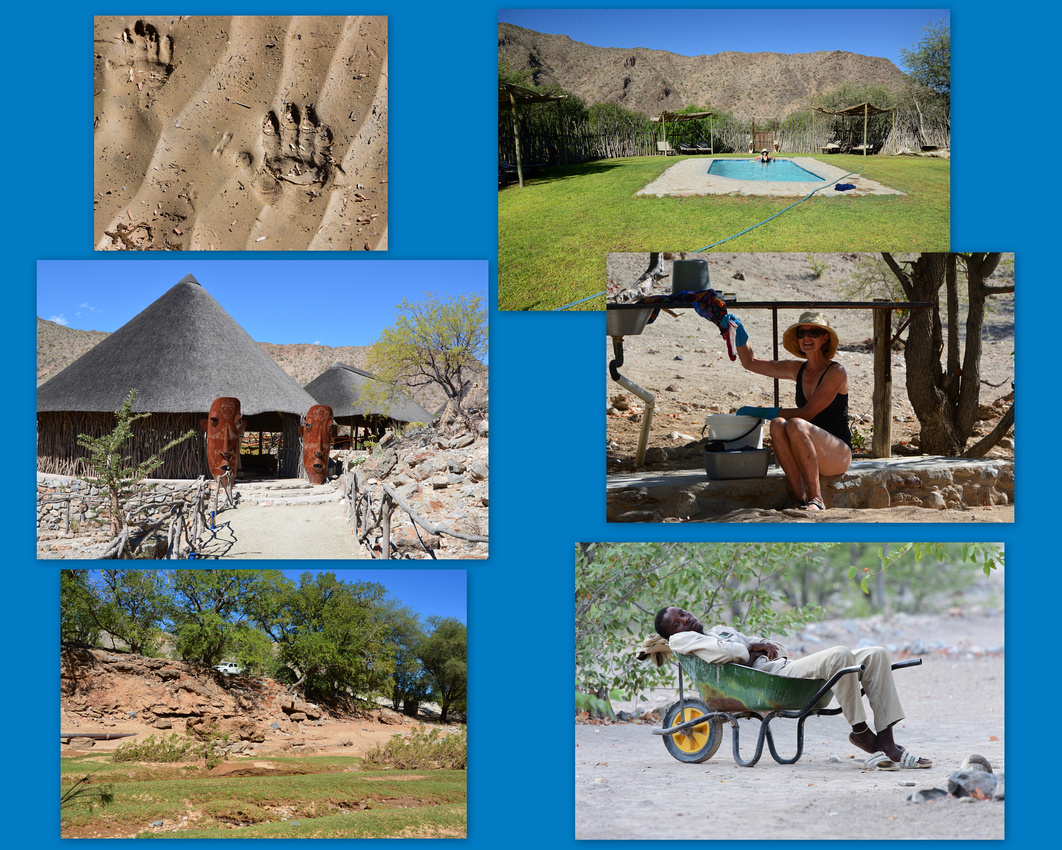



We retraced our tracks down the C43 passing two Himba girls next to the road, signalling that they were hungry. We turned round and gave them some 'droewors' (Afrikaans for dried sausage) - it's tough in Namibia where the unemployment rate is close to 30%. There is not a lot of money going around as jobs in the country are few and far between and many locals exist on selling crystals to tourists. These were the only members of the distinctive Himba tribe we saw on this trip so I am adding a photo of a Himba girl I took in 2012. Himba women are well known for covering themselves with an orange/ochre paste, a mixture of butterfat and ochre pigment, to cleanse the skin over long periods due to water scarcity and protect themselves from the extremely hot and dry climate as well as against mosquito and insect bites.



 We turned east at Palmwag along the C40 passing through Karamjab where the only petrol station was chaotic being the last day of the Easter weekend – Jenny captured some Herero ladies with their distinctive long dresses and horned hats enjoying a holiday treat. We continued on, turning off the now tarred C40 onto the gravel D2694/D2710 taking a shortcut to Etosha National Park.
We turned east at Palmwag along the C40 passing through Karamjab where the only petrol station was chaotic being the last day of the Easter weekend – Jenny captured some Herero ladies with their distinctive long dresses and horned hats enjoying a holiday treat. We continued on, turning off the now tarred C40 onto the gravel D2694/D2710 taking a shortcut to Etosha National Park.



 We entered through Anderson Gate, not having booked because of the holidays, and decided to base ourselves at the central Halali Camp. A curious local carrying his brother eyed us as we went through. As we drove along the main road between Okaukeujo and Halali Camps we came across a rhino, followed soon after by a cheetah. We saw a stationary car further up the road as we were turning off to the camp and went to investigate, finding a solitary battered old lion loping along the side of the road. Not a bad start to the Etosha experience.
We entered through Anderson Gate, not having booked because of the holidays, and decided to base ourselves at the central Halali Camp. A curious local carrying his brother eyed us as we went through. As we drove along the main road between Okaukeujo and Halali Camps we came across a rhino, followed soon after by a cheetah. We saw a stationary car further up the road as we were turning off to the camp and went to investigate, finding a solitary battered old lion loping along the side of the road. Not a bad start to the Etosha experience.










We had a lot of ‘lion’ luck - we found two lionesses and six cubs the next day followed by a male and female (captured by Jen) who we suspected had just had a bit of lion fun. We also came across a single male close to the first sighting and on the last day saw three lionesses lying in the shrubs.
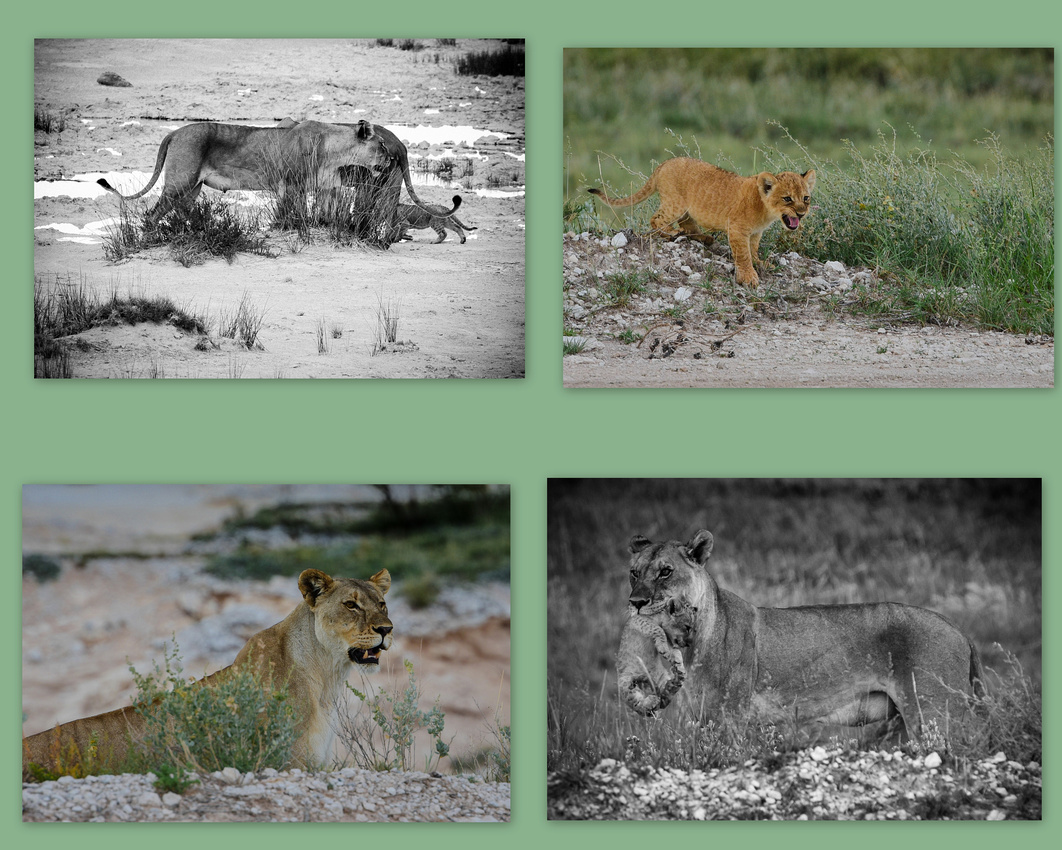



Cool hairstyle!




Jen's picture

 We saw quite a variety of other animals – more rhinos, the white clay on the elephant giving them a ghostly appearance, hyena, impala and the rarer black faced impala, giraffe, zebra, including one bullying another, ground squirrels and jackal.
We saw quite a variety of other animals – more rhinos, the white clay on the elephant giving them a ghostly appearance, hyena, impala and the rarer black faced impala, giraffe, zebra, including one bullying another, ground squirrels and jackal.















 The sign tell us what not to do in the park including sitting out the window but… when Capetonians do Etosha anything goes. There are many tour buses going through the park and I noticed one elderly participant having a snooze during lunch time.
The sign tell us what not to do in the park including sitting out the window but… when Capetonians do Etosha anything goes. There are many tour buses going through the park and I noticed one elderly participant having a snooze during lunch time.

 Birds in this collage clockwise: secretary bird, shaft tailed whydah, lilac crested roller and what looks like an amur falcon.
Birds in this collage clockwise: secretary bird, shaft tailed whydah, lilac crested roller and what looks like an amur falcon.

 Birds in this collage clockwise: Possible tawny eagle, hornbill, black busted and the lilac crested roller.
Birds in this collage clockwise: Possible tawny eagle, hornbill, black busted and the lilac crested roller.




Pale chanting goshawk



 Jen caught this busted in flight
Jen caught this busted in flight

 The Etosha landscape is magnificent, it rained one evening and we managed to get some images of the rain falling over the pan.
The Etosha landscape is magnificent, it rained one evening and we managed to get some images of the rain falling over the pan.
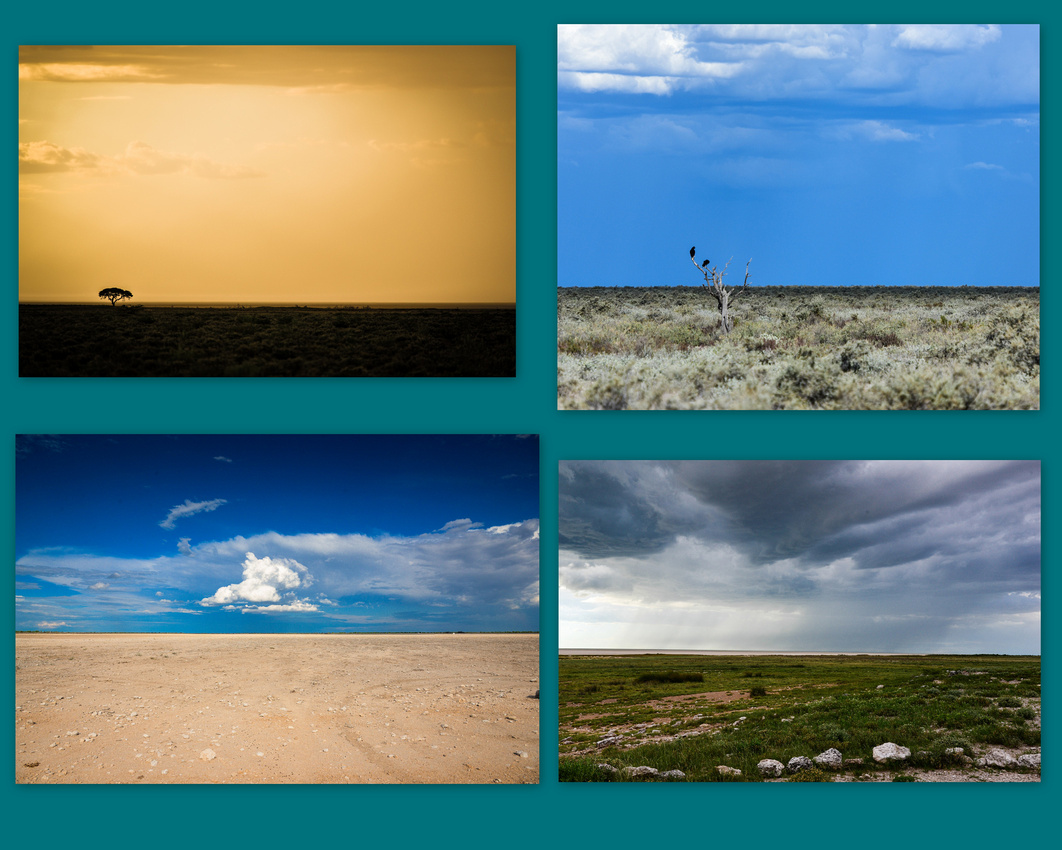







The campsite was busy with mainly German tourists while tour buses came and went. The site is electrified and you are able to buy beers, wood and meat from the local shop and campers can use the pool. We relied on our hotspot for the internet. There is also a service station that had run out of fuel over the weekend forcing us to drive to another camp to get diesel. There is a waterhole within the camp where Jen found a solitary rhino highlighted in the setting sun. I discovered a couple who were taking the mozzie threat really seriously!


Once leaving the Park we drove to Tsumeb and onto Grootfontein heading for Roy's Rest Camp on the tarred B8 road to Rundu. We spent three nights there resting and deciding what to do next as my leg was playing up. The camp is pleasant and has some quirky cabins, a few grass sites, a pool, cold beers, wood and wifi in the outdoors “Internet Café”. When we initially set out we planned to travel along the extent of the Caprivi Strip, down into Botswana and back to Windhoek. We eventually decided to only go up to the Kavango River and then return back to Windhoek.


Watched by a hornbill we set off driving up the straight C8 until we reached Rundu – chaotic on a Monday, prompting us to declare we would not be back into the centre of town again, if we could help it (sorry Mel). The road through the Caprivi Strip is as straight as a die and we passed numerous small villages many selling firewood. We noticed that its very tiring directing traffic!
The strip is a narrow protrusion of Namibia eastwards from the Okavango Region between Botswana to the south, and Angola and Zambia to the north. The German colony of German South West Africa (as Namibia was known) negotiated with Britain to annex the strip to give Germany access to the Zambezi River and a route to Africa's east coast. It is a corridor for African elephant moving from Botswana and Namibia into Angola, Zambia and Zimbabwe.

 We eventually turned off the main road to bump over the sandy track to Ngepi Camp site on the bank of the Kavango River the waters of which eventually fan out to become the Okavango swamps in Botswana. It was one of the best camps that we stayed in, with grass underfoot adjacent to the river bank. We could buy food and beers at the lodge and the site had electricity. You can swim in a cordoned off section of the fast flowing river. The toilet has a view of the river as does the bath. As I started the fire the first night I could hear hippos snorting and splashing across the river – our site had wooden posts embedded in the bank to deter hippos from lumbering up the bank and eating the grass and unsuspecting campers!
We eventually turned off the main road to bump over the sandy track to Ngepi Camp site on the bank of the Kavango River the waters of which eventually fan out to become the Okavango swamps in Botswana. It was one of the best camps that we stayed in, with grass underfoot adjacent to the river bank. We could buy food and beers at the lodge and the site had electricity. You can swim in a cordoned off section of the fast flowing river. The toilet has a view of the river as does the bath. As I started the fire the first night I could hear hippos snorting and splashing across the river – our site had wooden posts embedded in the bank to deter hippos from lumbering up the bank and eating the grass and unsuspecting campers!


We hired a mokoro (a hollowed out canoe) the following day where Chris our guide took us down the river drifting silently in the evening sun, herons circling overhead, white fronted bee-eaters flitting between branches, sleek black African darters diving from the trees. We stared silently and nervously at four or five hippos surfacing and snorting around twenty metres away. Chris told us as we returned to the camp that a hippo had turned the mokoro over a few days earlier – smart move as he would have lost a couple of customers if he had told us that earlier!



 The next day we drove round to the Bwabwata National Park across the river. This park is operated by the Department of Environment, not Namibia Wildlife Resorts, and as such is rustic and quiet in comparison. Apart from a rangers vehicle we saw no other cars that day and I am sure if we had broken down we could have spent a few days in there. J What looks like an elephant skull guards the gate.
The next day we drove round to the Bwabwata National Park across the river. This park is operated by the Department of Environment, not Namibia Wildlife Resorts, and as such is rustic and quiet in comparison. Apart from a rangers vehicle we saw no other cars that day and I am sure if we had broken down we could have spent a few days in there. J What looks like an elephant skull guards the gate.
Chris had told us that the 32nd light infantry Battalion of the South African army had been based there in a camp called Buffalo Base during the Angolan Civil war from which the soldiers made incursions into Angola. We found the remains of their dilapidated camp dotted amongst the trees. The legendary Colonel Breytenbach established the battalion and his name is found on the entrance wall.


Birds in this collage clockwise: lapwing, vultures, african jacana and a burchalls starling.
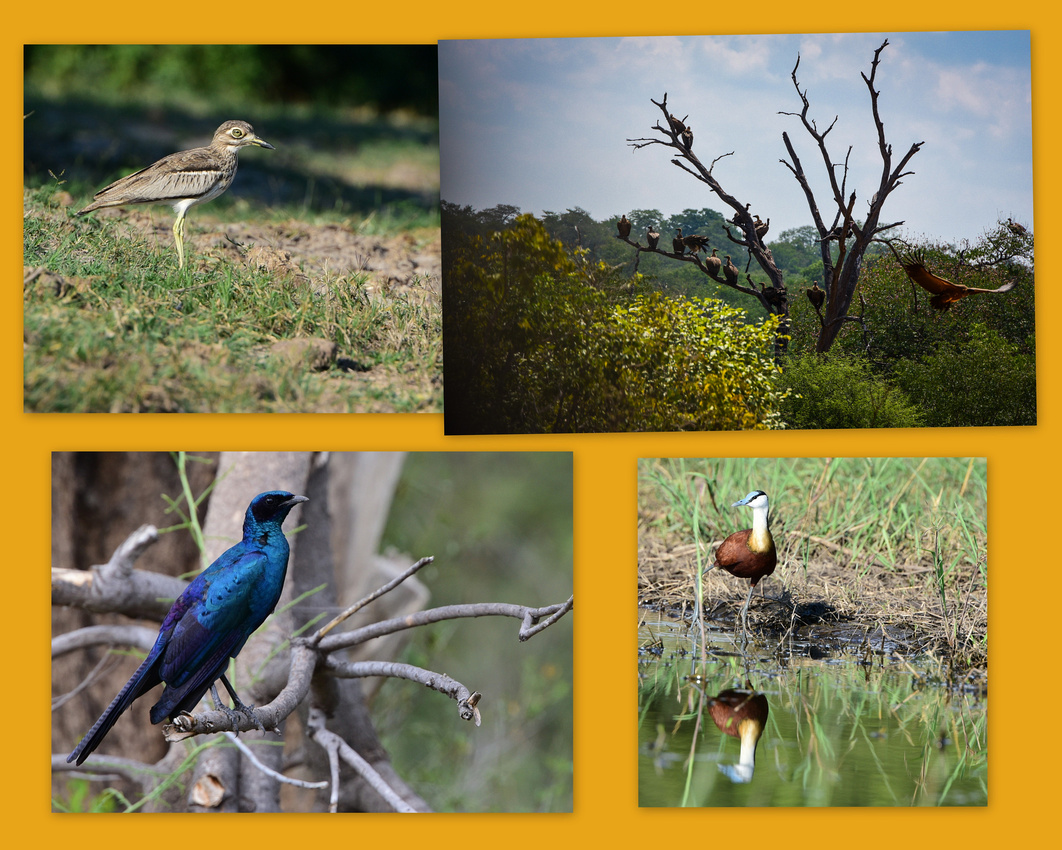

Red billed francolin


The African wattled lapwing


Possibly Burchalls coucal


Looks like two african darters

 We saw many vultures, kudu and warthog and a herd of Cape buffalo on our way out. I had never seen one in the flesh and this siting completed my lifetime grand slam of the big five – the other being the leopard (last seen in Londolozi 1983). Jen spotted a kudu with oxpecker earings J
We saw many vultures, kudu and warthog and a herd of Cape buffalo on our way out. I had never seen one in the flesh and this siting completed my lifetime grand slam of the big five – the other being the leopard (last seen in Londolozi 1983). Jen spotted a kudu with oxpecker earings J









 From our campsite, we regularly heard fish eagles calling from across the river and I heard a lion roaring late at night as I lay awake.
From our campsite, we regularly heard fish eagles calling from across the river and I heard a lion roaring late at night as I lay awake.
We drove for about six hours to our last camping site close to Otjiwarango and the Waterberg Plateau. As usual in Africa any form of transport will do including "Super star liner - The darling of the road." A shebeen is a local pub - I guess V6 gets you going. Both the Herero lady and the boy are wearing a Zionist Church star, described by the Enc. Britannica as a 'prophet healing church' based in Limpopo Province South Africa. Over a million followers gather annually at the headquarters over the Easter weekend.



 We stayed at the Weavers Rock Guest Farm overlooking the flat terrain interrupted by a few elevated hills. It was pleasant there but if you don’t like dogs barking at night give it a miss. We went for a walk with two of them at sunset where Jen and the dogs posed for me. The interior of our mansion for two months in all its glory below J
We stayed at the Weavers Rock Guest Farm overlooking the flat terrain interrupted by a few elevated hills. It was pleasant there but if you don’t like dogs barking at night give it a miss. We went for a walk with two of them at sunset where Jen and the dogs posed for me. The interior of our mansion for two months in all its glory below J

 To date we had escaped any tyre issues but as we set out to drive to Windhoek I noticed that air was leaking from one valve. As I had thought would happen, I could not undo the wheel nuts as the garage had tightened them beyond human endeavour. We decided to drive back to Otjiwarango as the tyre slowly deflated, trusting we would find someone to help on a Sunday morning. Luckily, at the local garage, a guy who looked like he had been there since before the war (the first one) disappeared into the back room and found a gizmo to replace the tyre stem while air blasted out of the valve. Fixed in 5five secs, very impressive.
To date we had escaped any tyre issues but as we set out to drive to Windhoek I noticed that air was leaking from one valve. As I had thought would happen, I could not undo the wheel nuts as the garage had tightened them beyond human endeavour. We decided to drive back to Otjiwarango as the tyre slowly deflated, trusting we would find someone to help on a Sunday morning. Luckily, at the local garage, a guy who looked like he had been there since before the war (the first one) disappeared into the back room and found a gizmo to replace the tyre stem while air blasted out of the valve. Fixed in 5five secs, very impressive.
We returned to Windhoek where Randal and Mel kindly hosted us for week while we caught up on washing, sleep and chocolate ice cream – thanks Randal J
We left for London two months after arriving (and driving 7,000 kms) having had a wonderful adventure, learning to camp while discovering more of this tremendous awe-inspiring country that we definitely want to return to.
As we packed up the tent at Ngepi we watched the sun rise over the river, a quiet peaceful moment to reflect that our African adventure was drawing to a close.
